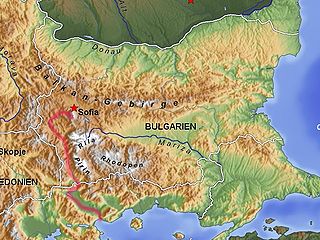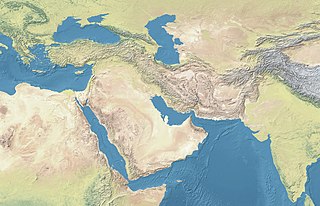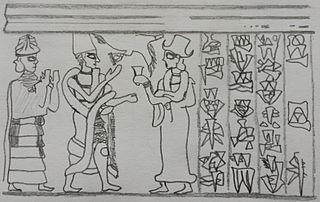
Xerxes I, called Xerxes the Great, was the fifth king of kings of the Achaemenid dynasty of Persia. Like his predecessor Darius I, he ruled the empire at its territorial apex. He ruled from 486 BC until his assassination in 465 BC at the hands of Artabanus, the commander of the royal bodyguard.

Ancient Greece was a civilization belonging to a period of Greek history from the Greek Dark Ages of the 12th–9th centuries BC to the end of antiquity. Immediately following this period was the beginning of the Early Middle Ages and the Byzantine era. Roughly three centuries after the Late Bronze Age collapse of Mycenaean Greece, Greek urban poleis began to form in the 8th century BC, ushering in the Archaic period and colonization of the Mediterranean Basin. This was followed by the period of Classical Greece, an era that began with the Greco-Persian Wars, lasting from the 5th to 4th centuries BC. Due to the conquests by Alexander the Great of Macedon, Hellenistic civilization flourished from Central Asia to the western end of the Mediterranean Sea. The Hellenistic period came to an end with the conquests and annexations of the eastern Mediterranean world by the Roman Republic, which established the Roman province of Macedonia in Roman Greece, and later the province of Achaea during the Roman Empire.

The Medes were an ancient Iranian people who spoke the Median language and who inhabited an area known as Media between western and northern Iran. Under the Neo-Assyrian Empire, late 9th to early 7th centuries BC, the region of Media was bounded by the Zagros Mountains to its west, to its south by the Garrin Mountain in Lorestan Province, to its northwest by the Qaflankuh Mountains in Zanjan Province, and to its east by the Dasht-e Kavir desert. Its neighbors were the kingdoms of Gizilbunda and Mannea in the northwest, and Ellipi and Elam in the south.

Elam was an ancient Pre-Iranian civilization centered in the far west and southwest of what is now modern-day Iran, stretching from the lowlands of what is now Khuzestan and Ilam Province as well as a small part of southern Iraq. The modern name Elam stems from the Sumerian transliteration elam(a), along with the later Akkadian elamtu, and the Elamite haltamti. Elamite states were among the leading political forces of the Ancient Near East. In classical literature Elam was also known as Susiana, a name derived from its capital Susa.

Umma was an ancient city in Sumer. There is some scholarly debate about the Sumerian and Akkadian names for this site. Traditionally, Umma was identified with Tell Jokha. More recently it has been suggested that it was located at Umm al-Aqarib, less than 7 km to its northwest or was even the name of both cities.

The Struma or Strymónas is a river in Bulgaria and Greece. Its ancient name was Strymṓn. Its drainage area is 17,330 km2 (6,690 sq mi), of which 10,797 km2 (4,169 sq mi) in Bulgaria, 6,295 km2 (2,431 sq mi) in Greece and the rest in north Macedonia. It takes its source from the Vitosha Mountain in Bulgaria, runs first westward, then southward, forming a number of gorges, enters Greek territory at the Kula village. In Greece it is the main waterway feeding and exiting from Lake Kerkini, a significant centre for migratory wildfowl. The river flows into the Strymonian Gulf in Aegean Sea, near Amphipolis in the Serres regional unit. The river's length is 415 kilometres.

The Attalid dynasty was a Hellenistic dynasty that ruled the city of Pergamon in Asia Minor after the death of Lysimachus, a general of Alexander the Great.
Gaius Antonius Hybrida was a politician of the Roman Republic. He was the second son of Marcus Antonius and brother of Marcus Antonius Creticus; his mother is unknown. He was also the uncle of the famed triumvir Mark Antony. He had two children, Antonia Hybrida Major and Antonia Hybrida Minor.

Mari was an ancient Semitic city in modern-day Syria. Its remains constitute a tell located 11 kilometers north-west of Abu Kamal on the Euphrates river western bank, some 120 kilometers southeast of Deir ez-Zor. It flourished as a trade center and hegemonic state between 2900 BC and 1759 BC. As a purposely-built city, the existence of Mari was related to its position in the middle of the Euphrates trade routes; this position made it an intermediary between Sumer in the south and the Levant in the west.
Khopesh is an Egyptian sickle-sword that evolved from battle axes.

Arrapha or Arrapkha was an ancient city in what today is northeastern Iraq, on the site of the modern city of Kirkuk.
The history of Mesopotamia ranges from the earliest human occupation in the Lower Sumaya period up to the Late antiquity. This history is pieced together from evidence retrieved from archaeological excavations and, after the introduction of writing in the late 4th millennium BC, an increasing amount of historical sources. While in the Paleolithic and early Neolithic periods only parts of Upper Mesopotamia were occupied, the southern alluvium was settled during the late Neolithic period. Mesopotamia has been home to many of the oldest major civilizations, entering history from the Early Bronze Age, for which reason it is often dubbed the cradle of civilization.

The Battle of Opis, fought in September 539 BC, was a major engagement between the armies of Persia under Cyrus the Great and the Neo-Babylonian Empire under Nabonidus during the Persian invasion of Mesopotamia. At the time, Babylonia was the last major power in western Asia that was not yet under Persian control. The battle was fought in or near the strategic riverside city of Opis, north of the capital Babylon. It resulted in a decisive victory for the Persians. A few days later, the city of Sippar surrendered to the Persians and Cyrus's forces entered Babylon apparently without a fight. Cyrus was subsequently proclaimed king of Babylonia and its subject territories, thus ending the independence of Babylon and incorporating the Babylonian Empire into the greater Persian Empire.
The Enchelii, the inhabitants of Enchele, were an Illyrian tribe that lived around the region of Lake Ohrid and Lynkestis, in modern-day Albania, the Republic of Macedonia and Greece.
Purushanda was an ancient city-state in central Anatolia, lying south of the Kızılırmak River in what is now modern Turkey. Its site has yet to be discovered. It may have been situated south-east of Lake Tuz, possibly on the mound of Acemhöyük approximately 6 kilometres (3.7 mi) north-west of the city of Aksaray. Another possible location is the mound of Karahöyük near Konya.

Tell Aran is a Kurdish-majority town in northern Syria, administratively part of the al-Safira District of the Aleppo Governorate, located southeast of Aleppo close to Sabkhat al-Jabbul. Nearby localities include Tell Hasil, al-Nayrab and Tell Shughayb to the northwest and al-Safira to the southeast. According to the Syria Central Bureau of Statistics (CBS), Tell Aran had a population of 17,767 in the 2004 census. The town is famous for its grapes, vineyards and gardens.
Khashshum, was a Hurrian city-state, located in southern Turkey most probably on the Euphrates river north of Carchemish.
The climate of ancient Rome varied throughout the existence of that civilization. In the first half of the 1st millennium BC the climate of Italy was more humid and cool than now and the presently arid south saw more precipitation. The northern regions were situated in the temperate climate zone, while the rest of Italy was in the subtropics, having a warm and mild climate. During the annual melt of the mountain snow even small rivers would overflow, swamping the terrain. The existence of Roman civilization spanned three climatological periods: Early Subatlantic, Mid-Subatlantic (175–750) and Late Subatlantic.

The Yamhad dynasty was an ancient Amorite royal family founded in c. 1810 BC by Sumu-Epuh of Yamhad who had his capital in the city of Aleppo. Started as a local dynasty, the family expanded its influence through the actions of its energetic ruler Yarim-Lim I who turned it into the most influential family in the Levant through both diplomatic and military tools. At its height the dynasty controlled most of northern Syria and the modern Turkish province of Hatay with a cadet branch ruling in the city of Alalakh.
Baliḫu also known as Ba-li-ih and Balaṭ-šarrani is an ancient, iron age town on the Euphrates in northern Syria.













